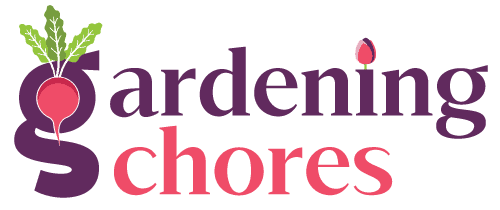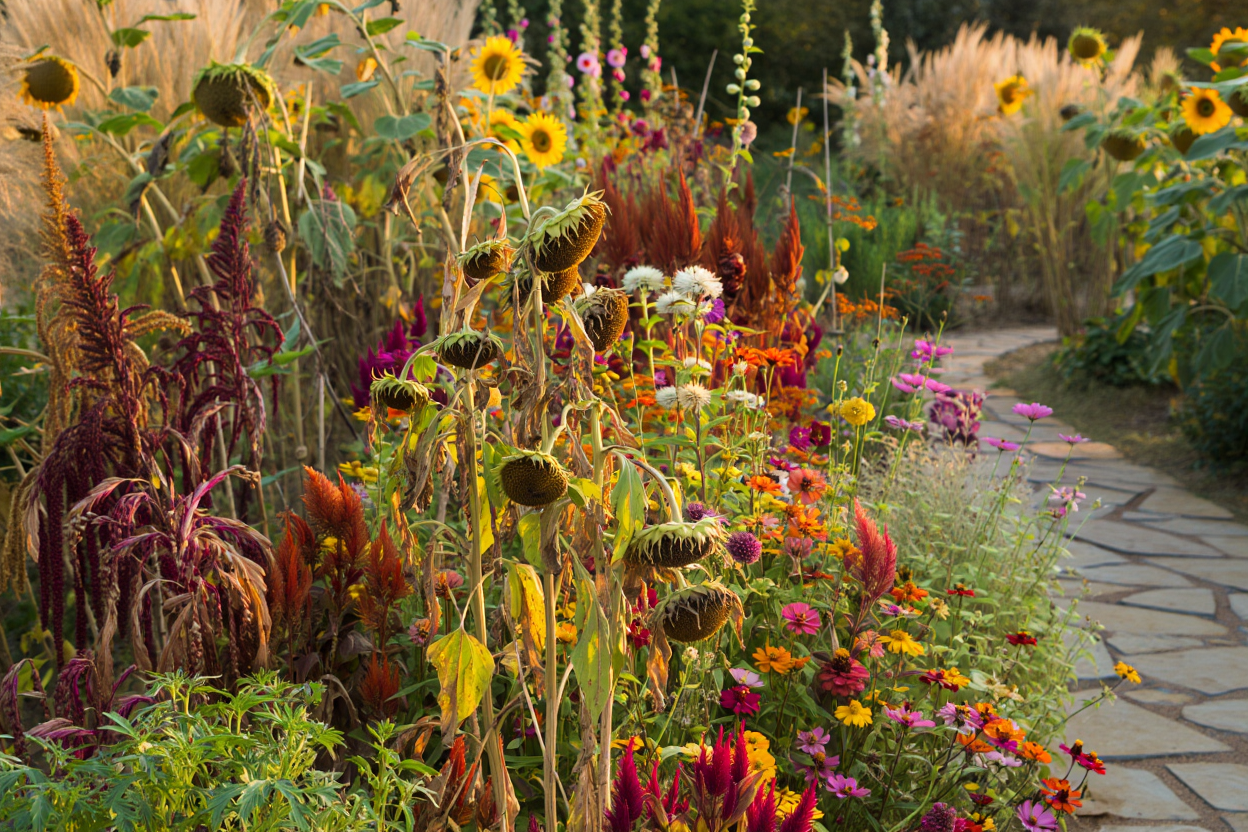
Letting your garden stand through winter feels like the right thing to do. And most of the time, it is.
You’ve probably heard it before — “Leave the seed heads for the birds.” It’s solid advice. Birds like goldfinches, sparrows, and juncos rely on dried seed heads when everything else is frozen or buried under snow.
So you skip the fall cleanup, leave the coneflowers, let the grasses wave in the wind, and feel good knowing you’re helping. But then spring shows up… and something’s off. Bulbs are missing. Tunnels crisscross your garden beds. Tulips that bloomed beautifully last year? Gone.
If this sounds familiar, you’re not alone — and you’re not doing anything wrong. You’re just getting the full story now.
The truth is, while some plants provide important food for birds in winter, others are doing something very different. They’re inviting in the wrong kind of guests — mice, voles, and other critters that treat your garden like a winter buffet. Once they settle in, they stay busy all season, tunneling through soil, chewing roots, and snacking on whatever they can find underground.
If you’ve ever tried to do the right thing for nature and ended up losing your tulips instead, you know how frustrating that feels. This doesn’t mean you need to cut everything down. But a few thoughtful cuts this fall can mean fewer surprises come spring — and a garden that’s just as kind to birds, but far less welcoming to the wrong guests.
1. Sunflowers (Helianthus annuus)
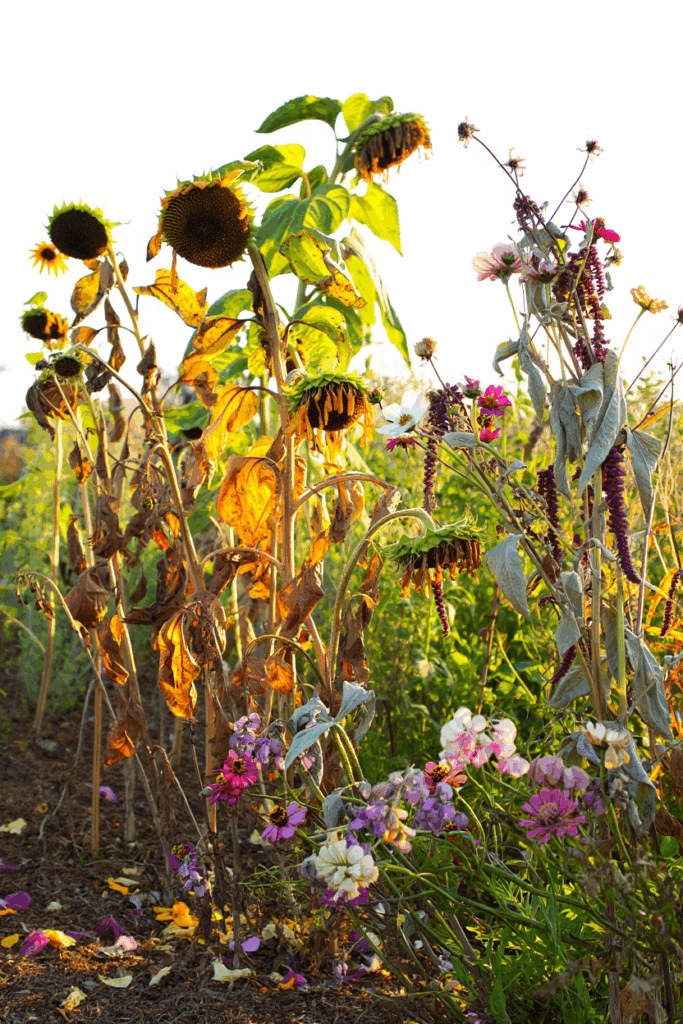
Sunflowers are a perfect example of how something beautiful can quietly cause problems once the season ends. Yes, birds absolutely adore sunflower seeds — you’ll see finches and chickadees clinging to the drying heads all through late summer. But once those big seed heads start to shatter and spill, it’s not the birds that come running — it’s the rats and mice.
A single dried head can drop hundreds of seeds, and when they scatter into mulch, compost piles, or soft soil, they turn into a ready-made food source. Those seeds are rich in fat and protein, exactly what small rodents need to build winter reserves. And unlike birds that pick and move on, mice hoard them. They’ll collect and stash seeds by the hundreds in burrows, sheds, and even the corners of garages — a problem that can escalate fast if you garden near buildings or animal feed.
The fix isn’t complicated. As soon as the back of the sunflower head starts to turn from green to yellow-brown, cut it and let it finish drying in a protected place like a porch or shed. Once the seeds loosen, hang the heads in mesh bags or suet cages where birds can still enjoy them without scattering seed across the ground. When the heads are stripped clean, compost the stalks — they’re perfectly safe to add back to the pile once the seeds are gone.
2. Bachelor’s Buttons (Centaurea cyanus)
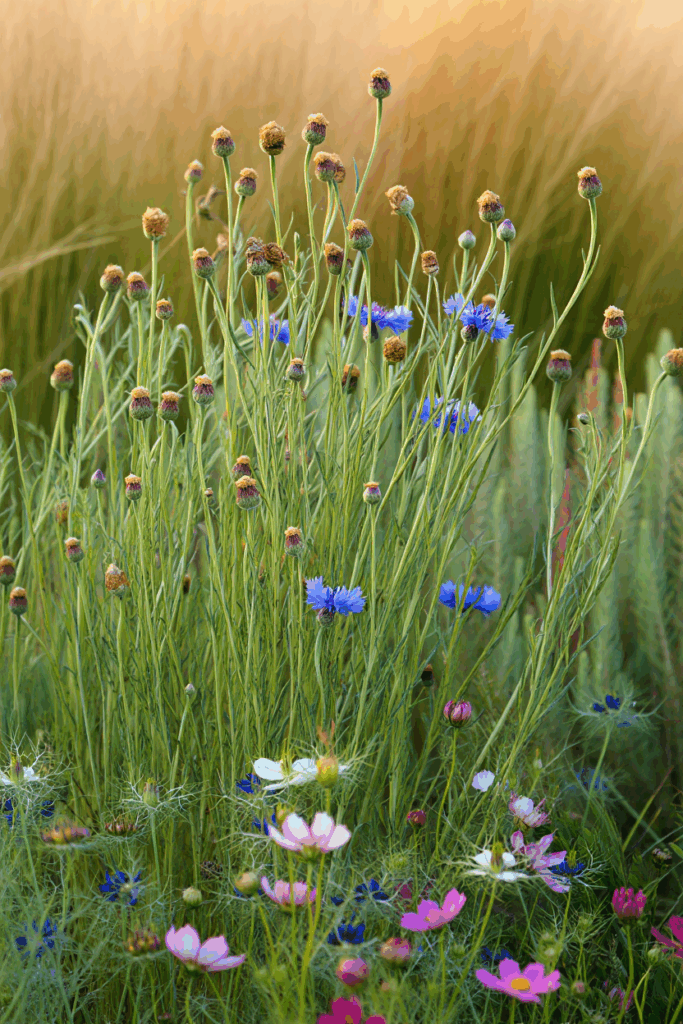
The same pattern happens with bachelor’s buttons, those sky-blue annuals that fill borders and cottage gardens in early summer. They’re lovely while they last — soft, airy, and perfect for bees — but by late season they become a quiet invitation for rodents. Each dried flower turns into a brittle, papery seed head that breaks apart in the breeze, scattering dozens of tiny, oil-rich seeds into the soil.
Mice love them, not just for the taste but for the dense energy they provide. Field studies have shown that deer mice and voles actively seek out seeds like Centaurea in late fall, collecting and storing them the same way squirrels hoard acorns.
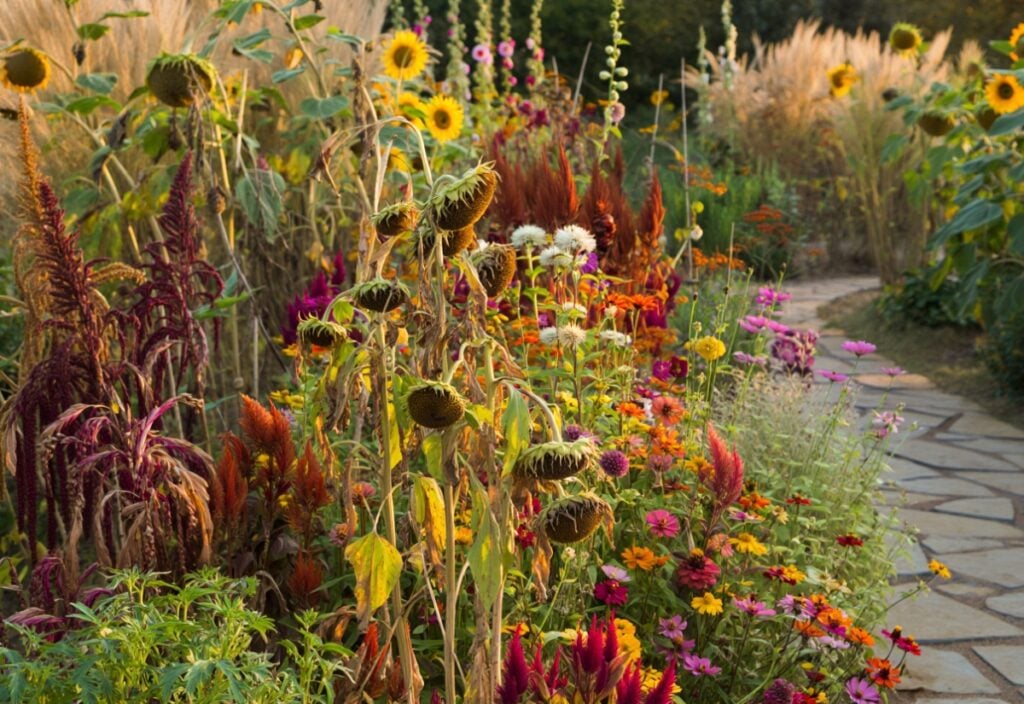
Once they find your garden, they often stick around, burrowing through mulch and gnawing on tender stems or roots nearby. It’s one of those slow-creeping problems that most gardeners don’t notice until spring — when the mulch seems to shift, the seedlings go missing, and you realize something’s been tunneling all winter long.
That’s why it’s smart to pull or mow bachelor’s buttons right after flowering, before the seed heads mature and release. If you’d like to save some seed for next year, snip a few heads early and dry them indoors in a paper bag.
3. Amaranth (Amaranthus cruentus, A. tricolor)
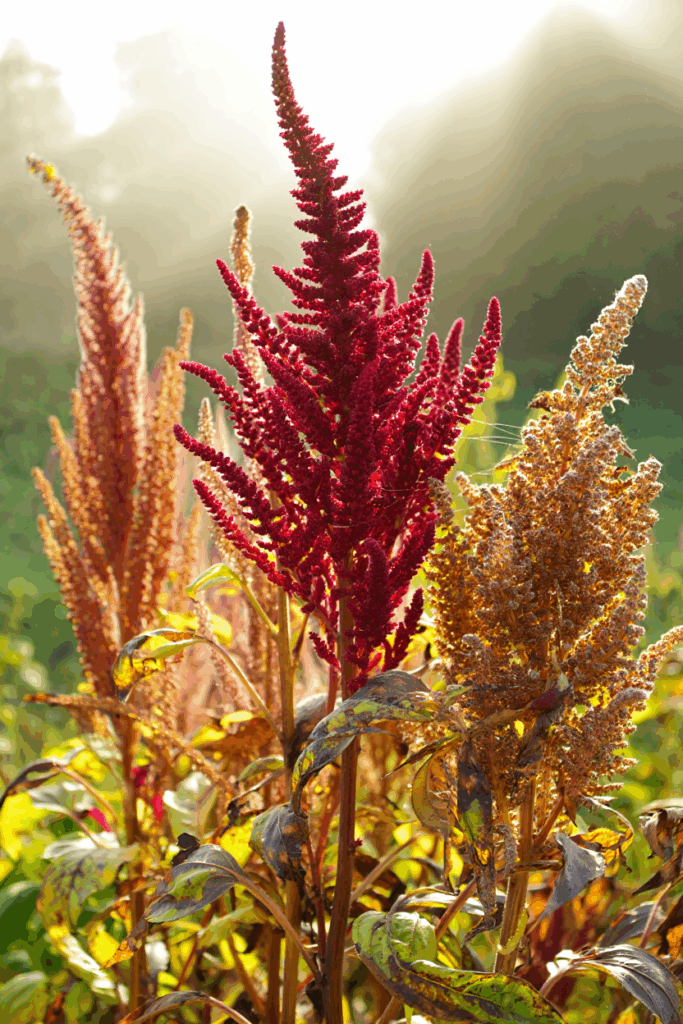
If you’ve ever grown amaranth, you know how mesmerizing those plumes can be — long, drooping tassels of crimson or bronze that sway in the autumn light. But by the time the color dulls and the heads dry, each plume is holding more than beauty. It’s holding thousands of tiny seeds, and that’s when the problems begin.
Most birds can’t access the seeds; they’re too fine and packed too deep in the flower heads. Once dry, they fall in a slow, steady rain into the soil and leaf litter below — an invisible carpet of calories that rodents are quick to discover.
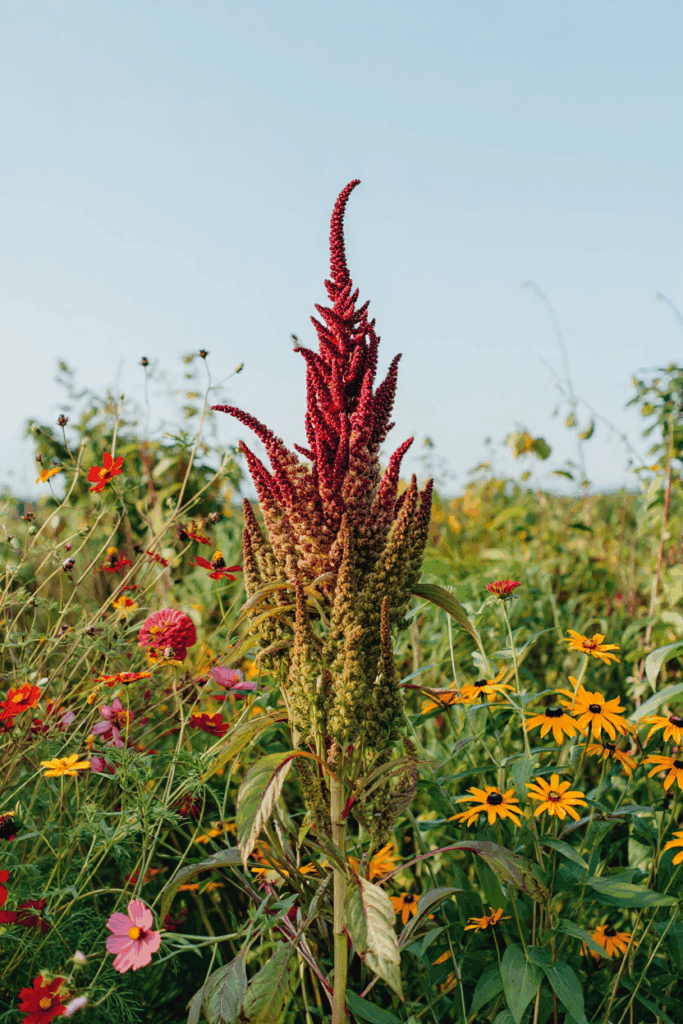
Mice will comb through the fallen seed like they’re harvesting grain, caching it underground in small pockets where it stays protected all winter. Those caches don’t just feed them — they help sustain larger rodent populations that will be ready to reproduce come spring.
To keep your amaranth from becoming a winter seed bank, harvest the plumes before they start shedding. When the color fades and the texture feels papery, cut them and hang them somewhere airy to finish drying. You can save the seeds for cooking or use them in homemade bird feed — they’re perfectly edible. Then clear the stalks before frost so the ground stays clean.
4. Nasturtiums (Tropaeolum majus)
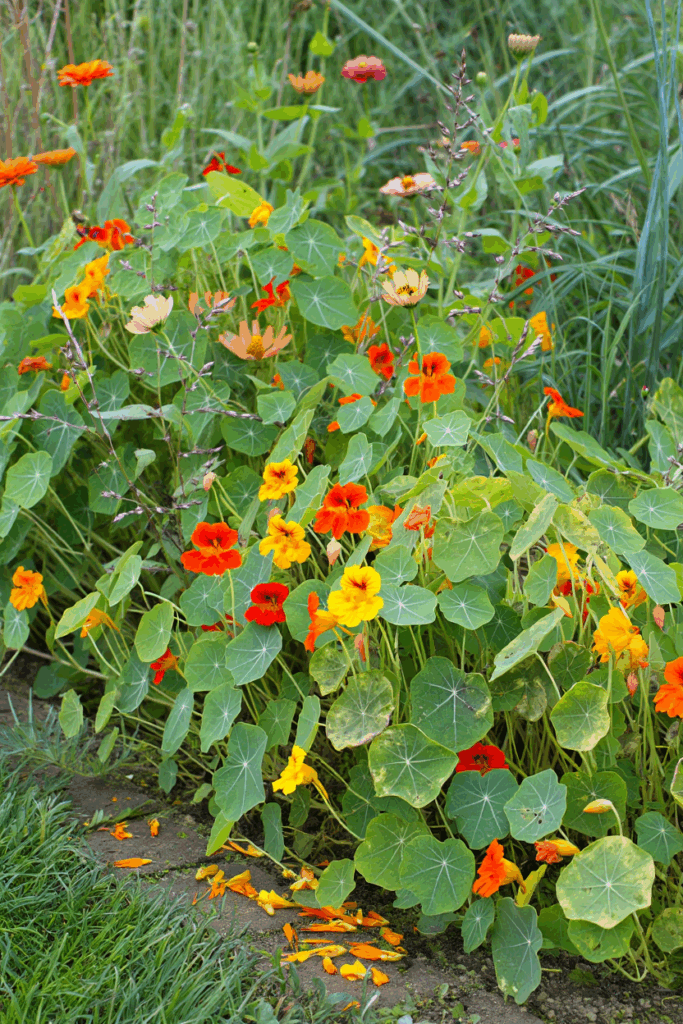
Nasturtiums are the definition of cheerful — spilling from baskets, tumbling over walls, and blooming nonstop until frost. But when the vines finally fade, they leave behind those pale, round seeds that look like little marbles. They drop fast and roll far, tucking themselves into cracks, under stones, and through piles of fallen leaves — exactly the kind of hiding spots rodents love.
Birds don’t eat nasturtium seeds, but mice and voles do. They’ll collect and store them along garden edges, and because the seeds are hard and resilient, many survive the winter. In mild climates, they even sprout in early spring, popping up between pavers or in vegetable beds where you least expect them. It’s one of those small, overlooked details that can quietly create both weed problems and rodent cover.
The solution is simple: once frost blackens the vines, pull them promptly and compost them before the pods harden. The plants break down easily, and you can always dry a few seeds indoors if you want to replant them next year. It’s a quick cleanup that keeps the garden tidy, the rodents hungry, and the next season’s planting much easier to manage.
5. Nigella (Nigella damascena, love-in-a-mist)
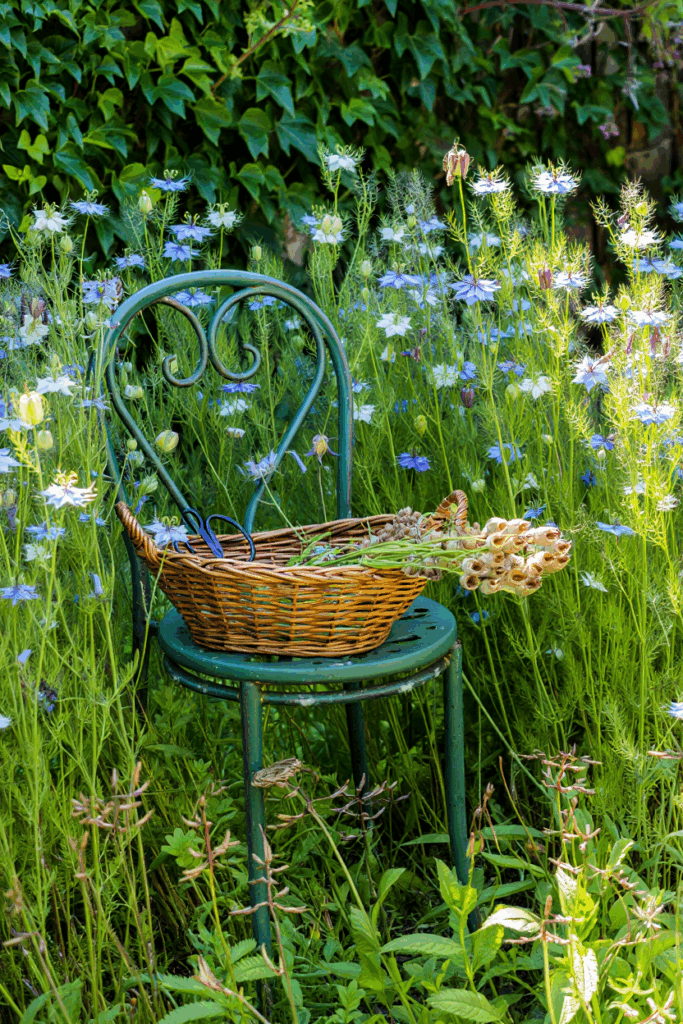
By midsummer, Nigella looks like something out of a fairytale — those fine, feathery leaves surrounding pale blue blooms that turn into intricate seedpods shaped like little lanterns. They’re so pretty when they dry that most gardeners leave them standing, thinking they’ll add charm through fall. But those pods are loaded with tiny, aromatic seeds — hundreds per plant — and once the shells split, they pour straight into the soil.
It’s part of what makes Nigella a generous self-seeder, but it’s also what draws in rodents. Mice and voles can smell those oily seeds from feet away. They’ll slip through the fading foliage at night, collecting them in their cheeks and stashing them under mulch, rocks, or the base of fences. Over winter, those small caches feed entire families and keep them nesting near the same garden beds you’ll replant next spring.
If you love saving those pods, harvest them before they turn brittle and start to crack. Hang them upside down indoors until dry, then save the seeds for crafts or future planting. Once frost hits, clear what’s left in the garden. You’ll still have all the beauty of those lacy seedpods — without feeding the wrong guests through winter.
6. Zinnias (Zinnia elegans)

Zinnias are impossible not to love — they’re bold, colorful, and humming with bees and butterflies from the first heat of summer to the last warm days of fall. But by October, those same bright flowers are quietly shifting roles. As the petals curl and the centers dry, the heads fill with flat, papery seeds. Every stiff stalk holds dozens, sometimes hundreds, and when the wind shakes them loose, most tumble right to the ground.
Finches will take a few, but they can’t keep up. The rest mix into the mulch where rodents get to them first. Mice scoop them up one by one, hoarding them underground like currency for the cold months ahead. It’s an easy food source that encourages them to linger — and they don’t just stay in the flower bed. Once settled, they’ll explore every corner of the garden.
7. Celosia (Celosia argentea, cockscomb)
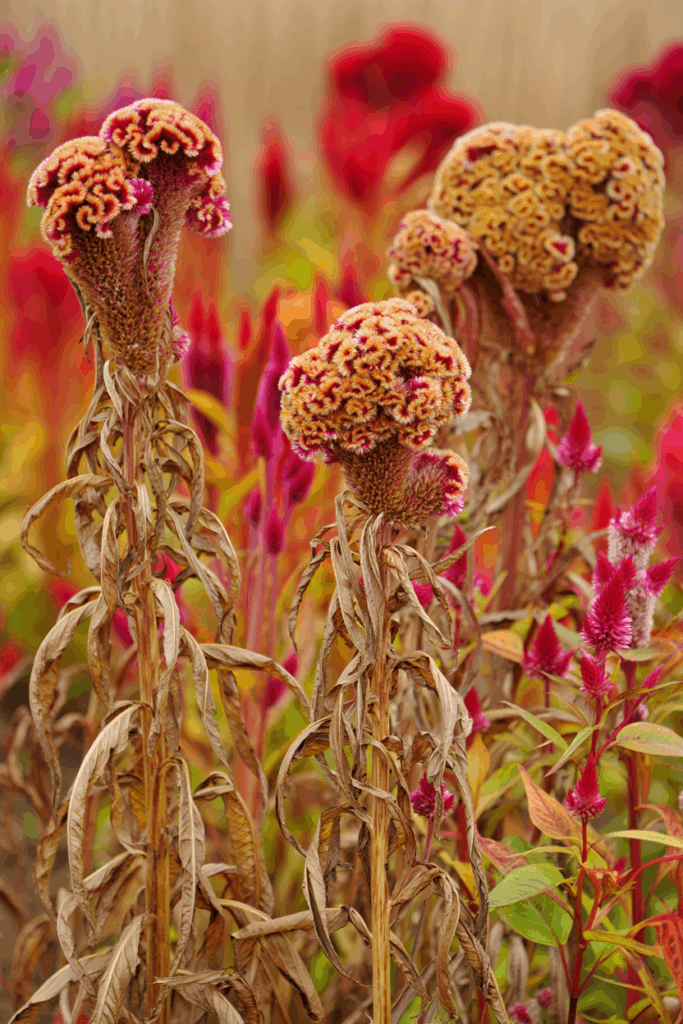
Celosia’s late-summer color is hard to miss — vivid plumes and coral-like crests that keep glowing long after other annuals fade. But by fall, those same blooms begin releasing thousands of tiny black seeds, almost dust-like in size. Once the heads dry, every breeze or passing bird shakes loose more, scattering them into the soil.
The problem is that birds rarely eat celosia seed. It’s too fine and slick for most songbirds to bother with. Rodents, on the other hand, find it easily. Mice forage under the dying stalks, gathering seeds and caching them underground or along stone borders. The old stems and leaf litter provide cover, turning a once-brilliant border into a quiet feeding zone through early winter.
To keep it from becoming a long-term seed source, cut the heads when they begin to dull in color and feel dry. If you want to save a few for drying, hang them indoors — they’ll keep their shape beautifully. Compost the rest before the seed heads shatter. It’s a quick job that stops unwanted self-sowing and cuts off another easy meal for rodents settling in for the season.
8. Japanese Anemone (Anemone hupehensis and hybrids)

Japanese anemones are among the last perennials to bloom, lighting up the fall garden with their delicate pink or white flowers. But once the petals drop, the stalks remain topped with small, fluffy seed heads that linger close to the ground. As they open, they scatter fine seed into the surrounding soil — not a lot at once, but enough to draw small rodents foraging before the first frost.
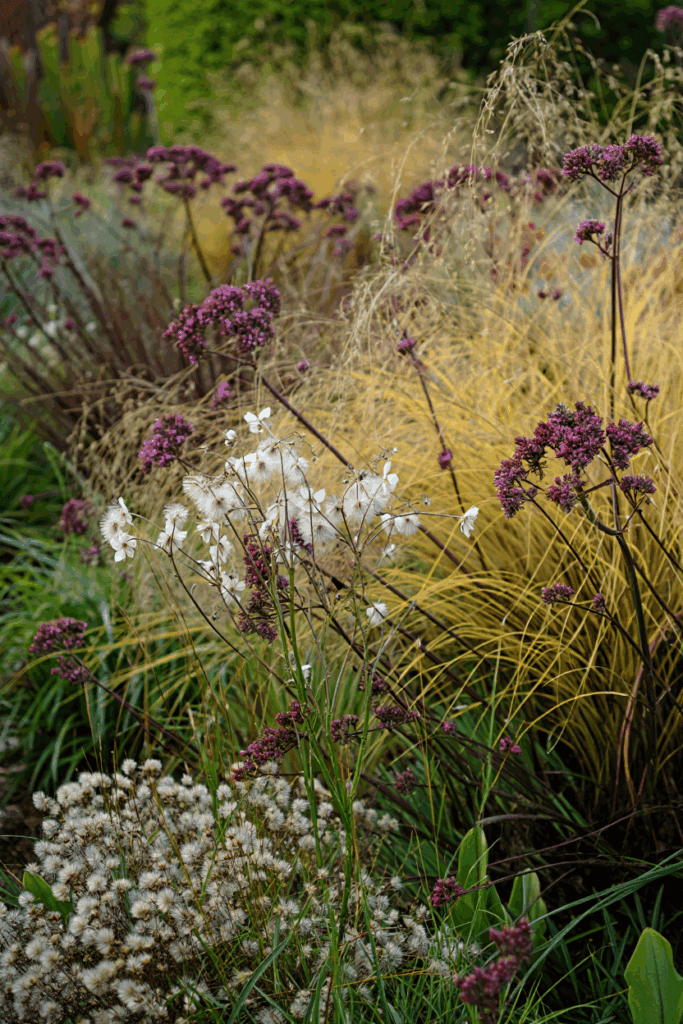
The structure of the plant adds to the appeal. As cold sets in, the dense mat of leaves and roots at the base stays warmer than the open soil, providing both cover and nesting material. Mice use these sheltered crowns as feeding spots, digging shallow holes around the stems as they search for leftover seed.
A simple fall cleanup makes all the difference. Once the blooms fade, cut the stalks down before the seed heads fluff out completely. Clear away the lower foliage so air can move freely through the crown. The plant will overwinter better, and you’ll eliminate one of the last reliable food-and-shelter combinations left standing in the fall garden.
9. Sweet Pea (Lathyrus odoratus)
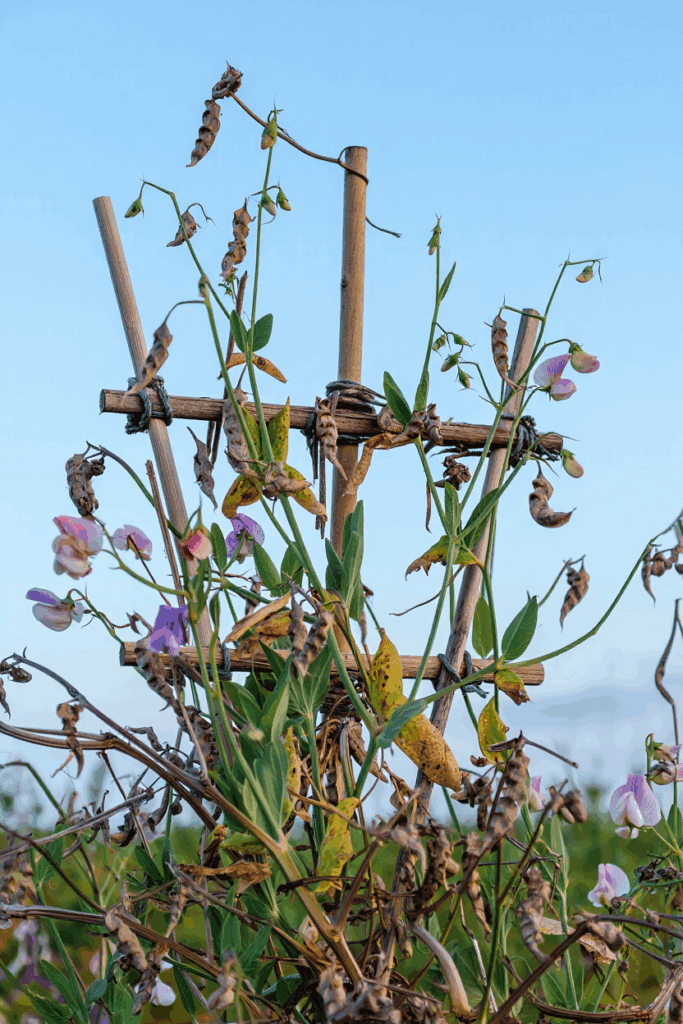
Sweet peas end the season differently from most climbers. When the blooms fade, the vines stay green for weeks, quietly ripening pods along their length. Each pod holds several round, starchy seeds — harmless to us, but irresistible to rats and mice. Birds rarely touch them, so when the pods dry and split, the seeds spill directly into the soil below the trellis.
By late fall, that combination of fallen seed and tangled vines creates perfect conditions for rodents: food, shelter, and warmth all in one place. You might not see them at first, but tunnels through mulch or nibbled seedlings nearby are usually the first signs they’ve moved in.
The best time to act is when the pods first start to rattle when shaken. Pull the vines before they harden fully and scatter their seeds. Save a few pods indoors for next spring’s planting if you like, but don’t leave them hanging through winter. Once the vines are gone, the soil surface dries, the cover disappears, and the rodents move on to easier feeding grounds.
10. Cleome (Cleome hassleriana, spider flower)
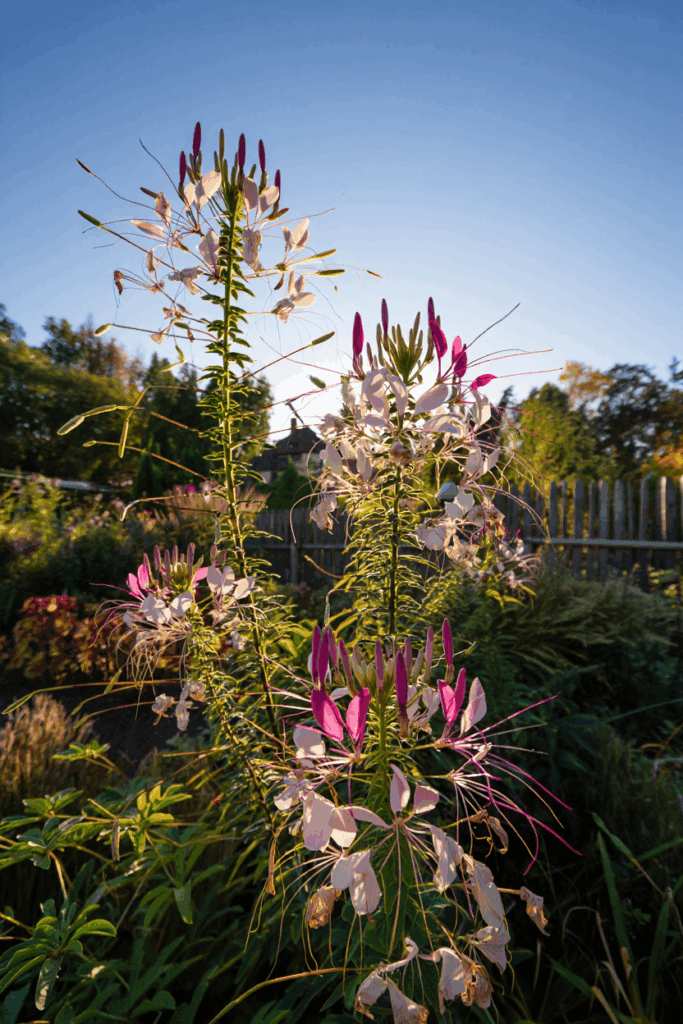
If you’ve ever grown cleome, you know how it seems to take over by the end of the season. Those tall, sticky stems keep flowering right into fall, each bloom leaving behind a long, slender seedpod. By October, those pods are full — hundreds of tiny black seeds inside every one. When they dry, they pop open with the slightest touch, scattering seeds like pepper across the soil.
Most gardeners worry about cleome reseeding everywhere (and it does), but there’s another side to it. Those tiny seeds are exactly the kind of food rodents look for as nights turn cold. Birds don’t eat them — they’re too fine and slick — so the leftovers stay right on the soil surface where mice and voles forage. Add the shelter of tall, woody stalks, and you’ve got perfect feeding cover.
The easy fix is to act before the pods burst. Once the stems fade and the pods turn tan, pull or cut the plants and compost them. If you want to save seed, snip a few pods early and dry them indoors — they’ll store well. Cleaning up now keeps cleome from spreading where you don’t want it and keeps rodents from finding an easy late-season meal.
11. Hollyhocks (Alcea rosea)
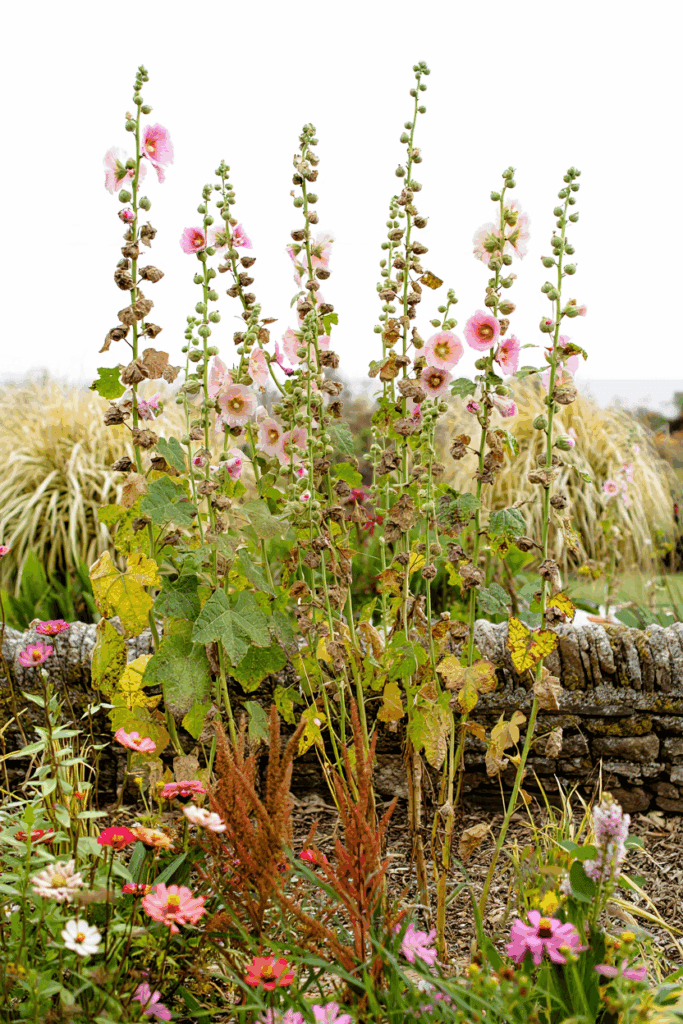
Hollyhocks are one of those classic cottage flowers that everyone loves — tall spires of color that stand up to summer heat. But by late fall, when the blooms are long gone, those same stalks turn into quiet seed factories. Each papery disk holds a ring of flat seeds that drop straight down once dry. Birds usually ignore them, but mice don’t.
Because hollyhocks tend to grow near walls, sheds, or fences, the fallen seed often lands in places that already offer cover and warmth. That’s prime territory for rodents preparing to overwinter. The dry stalks trap leaf litter, and before long, you’ve got both food and nesting shelter in the same spot.
To break that cycle, don’t wait until frost flattens them. When the pods begin to rattle and the stalks turn brown, cut them at the base. Save a few seed heads if you’d like — they’re easy to dry and replant — and compost the rest. It’s a simple end-of-season task that keeps your borders tidy and discourages mice from settling in for the winter.

Written By
Amber Noyes
Amber Noyes was born and raised in a suburban California town, San Mateo. She holds a master’s degree in horticulture from the University of California as well as a BS in Biology from the University of San Francisco. With experience working on an organic farm, water conservation research, farmers’ markets, and plant nursery, she understands what makes plants thrive and how we can better understand the connection between microclimate and plant health. When she’s not on the land, Amber loves informing people of new ideas/things related to gardening, especially organic gardening, houseplants, and growing plants in a small space.
